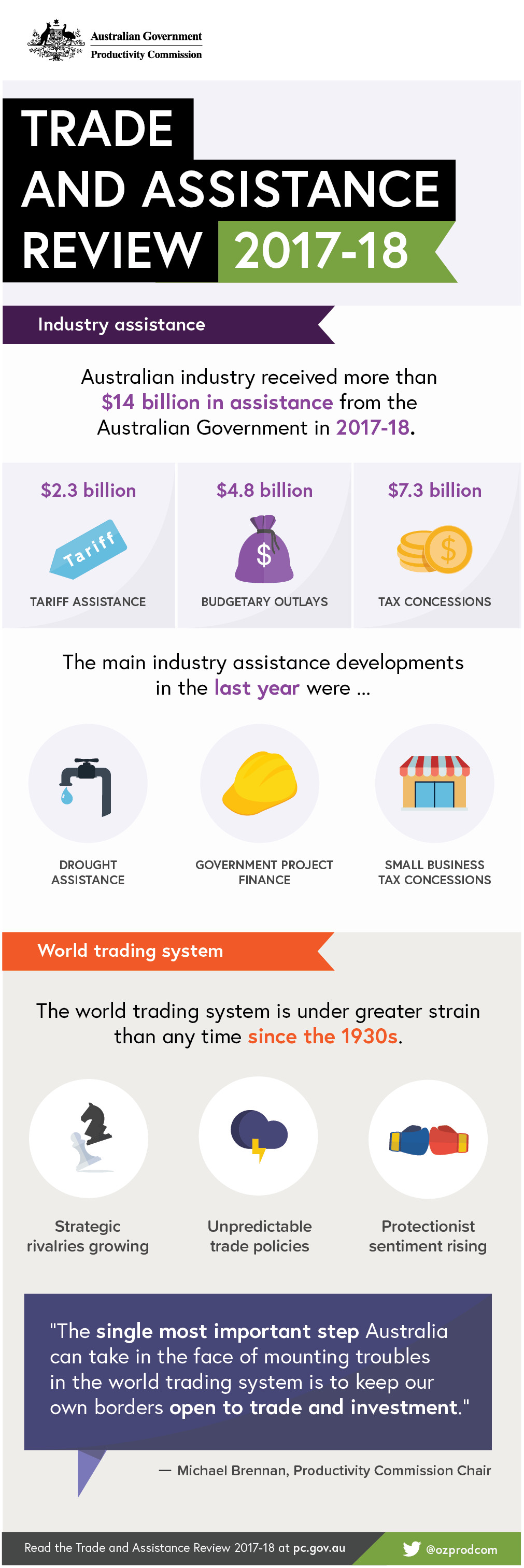Trade and Assistance Review 2017-18
Annual report series
The Trade and Assistance Review 2017-18 was released on 12 June 2019.
The review contains the Commission's latest quantitative estimates of Australian Government assistance to industry. This year's review also provides information on tax concessions and budgetary outlays that may be construed as assistance. A theme chapter discusses the future of the world trading system.
Download the theme chapter
- The future of the world trading system (PDF - 699 Kb)
- The future of the world trading system (Word - 181 Kb)
Download the report
- Trade and Assistance Review 2017-18 (PDF - 2286 Kb)
- Trade and Assistance Review 2017-18 (Word - 1058 Kb)
Methodological Annex
- At a glance
- Infographic
- Supporting data
Media release
World trade faces biggest challenges since 1930's
The world trading system is under greater strain than at any time since the 1930s and can no longer be taken for granted, the Productivity Commission finds in its latest Trade and Assistance Review.
"Protectionist sentiment is once again on the rise around the world. Unfortunately, we are seeing the language of market gain give way to the language of strategic rivalry, resulting in unpredictable trade policy. This is bad for business and bad for jobs," Productivity Commission Chair Michael Brennan said.
"The single most important step Australia can take in the face of mounting troubles in the world trading system is to keep our own borders open to trade and investment," Mr Brennan said.
"The certainty of the rules-based trading system is of immense benefit to Australia and is a pillar of a strong global economy. It has helped to underpin 27 years of growth in Australia and to lift a billion people out of poverty around the world," Commissioner Jonathan Coppel said.
The importance of strengthening in an even-handed manner the rules-based system governing international trade cannot be underestimated.
Australia should also continue to work with other countries to build consensus on how to resolve long-standing and escalating challenges facing the World Trade Organisation (WTO).
"We hurt the incomes of average Australians by imposing nuisance tariffs on the goods they buy, requiring complex 'rules of origin' in trade agreements, and running one of the world’s most active anti-dumping schemes. We only harm ourselves with these policies," Mr Brennan said.
Australian industry received more than $14 billion in assistance from the Australian Government in 2017-18. Tax concessions made up $7.3 billion of this figure; budgetary assistance $4.8 billion; and tariffs $2.3 billion. The main developments in the past year were increases in drought assistance, the ongoing proliferation of government project finance vehicles, and the progressive ramping up of small business tax concessions.
The Commission's figures for industry assistance are conservative as they don't include the significant assistance provided by government through favourable finance, local purchasing preferences, and regulatory restrictions on competition.
The Trade and Assistant Review 2017-18 can be found at: www.pc.gov.au/research/ongoing/trade-assistance/2017-18
Read the report above.
Contents
- Preliminaries: Cover, Copyright and publication detail, Foreword, Contents and Abbreviations
- Chapter 1 Key results and policy developments
- 1.1 Industry assistance estimates
- 1.2 Recent developments in industry assistance
- 1.3 The future of the world trading system
- Chapter 2 Assistance estimates
- 2.1 Tariff assistance
- 2.2 Australian Government budgetary assistance
- 2.3 Combined assistance and effective rates of assistance
- 2.4 Effective rates of assistance since 1970
- Chapter 3 The future of the world trading system
- 3.1 The world trading system: what is it and what has it achieved?
- 3.2 The challenges facing the world trading system
- 3.3 A path forward
- Chapter 4 Recent developments in industry assistance
- 4.1 Drought assistance
- 4.2 Government project finance facilities
- Chapter 5 Trade policy developments
- 5.1 Multilateral and plurilateral trade agreements
- 5.2 Bilateral and regional agreements
- 5.3 Australia’s WTO disputes
- 5.4 Australia’s anti-dumping and countervailing activity
- Appendix A Detailed estimates of Australian Government assistance to industry
- References
Infographic: Trade and Assistance Review 2017-18
Download the infographic

Trade and Assistance Review 2017-18 (text version of the infographic)
Industry assistance
Australian industry received more than $14 billion in assistance from the Australian Government in 2017-18.
- $2.3 billion Tariff assistance
- $4.8 billion Budgetary outlays
- $7.3 billion Tax concessions
The main industry assistance developments in the last year were:
- Drought assistance
- Government project finance
- Small business tax concessions
World trading system
The world trading system is under greater strain than any time since the 1930s.
- Strategic rivalries growing
- Unpredictable trade policies
- Protectionist sentiment rising
'The single most important step Australia can take in the face of mounting troubles in the world trading system is to keep our own borders open to trade and investment.'
— Michael Brennan, Productivity Commission Chair
Read the report above.
The following excel files contain tables of data used to make the charts within the Trade and Assistance Review 2017-18. There is also an extra file with data of Australian Government budgetary assistance by program.